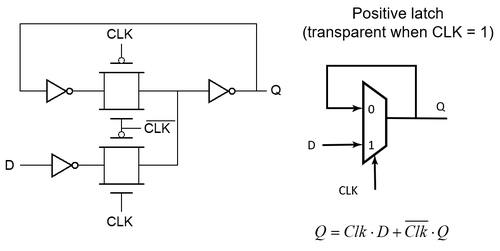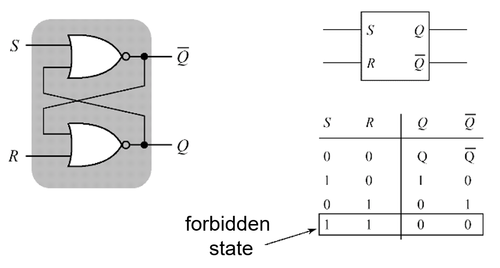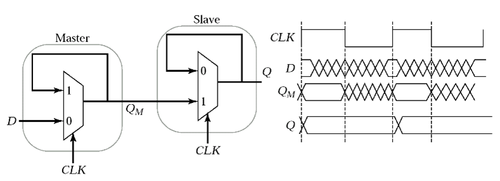Difference between revisions of "CoE 197U Memory"
| Line 29: | Line 29: | ||
Read through the rest of the slides for the related timing parameters of latches and registers. | Read through the rest of the slides for the related timing parameters of latches and registers. | ||
| − | == Non-volatile Memory == | + | == Optional: Non-volatile Memory == |
When using memory elements as an array for storage of larger amounts of data (as opposed to just a variable or two), one commonly used memory element is the static random access memory (SRAM). Compared to registers, SRAMs occupy smaller area. Being static, they retain the data for as long as power is ON, without the need of a refresh circuit. However, they are still considered as temporary storage in that the stored data is lost once power is cut off. For systems where we need data to be retained even when power is turned OFF (e.g., boot/start-up configuration), we need to use non-volatile memory (NVM). Commonly used NVM are read only memory (ROM) and Flash. | When using memory elements as an array for storage of larger amounts of data (as opposed to just a variable or two), one commonly used memory element is the static random access memory (SRAM). Compared to registers, SRAMs occupy smaller area. Being static, they retain the data for as long as power is ON, without the need of a refresh circuit. However, they are still considered as temporary storage in that the stored data is lost once power is cut off. For systems where we need data to be retained even when power is turned OFF (e.g., boot/start-up configuration), we need to use non-volatile memory (NVM). Commonly used NVM are read only memory (ROM) and Flash. | ||
Emerging memory have recently been introduced, such as the resistive RAM (ReRAM) and magneto-resistive RAM (MRAM). These emerging memory elements are non-CMOS devices but can still be interfaced with CMOS. | Emerging memory have recently been introduced, such as the resistive RAM (ReRAM) and magneto-resistive RAM (MRAM). These emerging memory elements are non-CMOS devices but can still be interfaced with CMOS. | ||
Latest revision as of 20:12, 28 March 2023
Use the provided slide deck to guide you through this discussion.
The main reference for this lecture is the Digital IC book[1]
Memory Classification
Memory can be classified according to different categories. Memory can be either foreground (as part of logic, such as in sequential circuits) or background (as a large storage). Memory can also be classified as either static, that is the data is retained as long as power is ON, or dynamic, where constant refreshing of the data is needed. In sequential circuit, we can also classify memory as either a register (or sometimes referred as flip-flops, meaning edge sensitive) or a latch (meaning level sensitive). Especially for embedded systems, we would require memory storage that can retain data (for example configuration settings) even when power is OFF. This is what we call as non-volatile memory, as opposed to volatile memory, which are temporary storage and retains data only while power is ON.
Memory Elements
Static memory rely on the principle of positive feedback to achieve two possible states, or what we call a bistable circuit, represented as either a 0 or a 1. Fig. 1 shows the basic idea of positive feedback, illustrated by 2 inverters connected in a ring. Considering the first inverter, the input is Vi1 and output is Vo1, and the corresponding VTC is shown on the left. For the second inverter, the input is Vi2 = Vo1 and the output is Vo2 = Vi1. So we can flip the VTC as shown on the right, so the axes of both plots coincide. As such, we can combine as shown on the figure at the bottom. Here we can see that we have 3 operating points: A (Vi1=0, Vo1 = 1), B (Vi1 = 1, Vo1 = 0) and C. Point C is known as the metastable state. That is, assuming the inverter pair in Fig. 1 happens to be biased at point C, a small deviation or noise can shift to either point A or point B. This is illustrated in Fig. 2. A small deviation d gets amplified through the inverter pair causing the operating point to shift from C to A and stay at A. From either point A or B, however, even a larger deviation will not shift the operating point, making point A and B stable states.
One possible implementation of the latch is the mux-based, as shown in Fig. 3. Here, while CLK = 1, the lower transmission gate is closed, giving a direct path from D to Q. Once the CLK goes low, the lower transmission gate opens while the top transmission gate closes. Thus the path from D is disconnected while the data in Q gets stored through the inverter pair. A more common latch implementation is the cross-coupled NOR SR latch (may also be implemented using cross-coupled NAND) as shown in Fig. 4.
Dynamic latches store data through parasitic capacitances as shown in Fig. 5 on the left. However, the charge on the capacitance may be discharged especially of the clock period is long. As such some refreshing mechanism is needed to ensure that the charge in the capacitor is replenished and therefore data will not be lost. A possible solution to this is the peudo-static latch, where a small keeper inverter is added to provide the positive feedback for the data and therefore no refreshing is necessary.
Registers or edge-triggered flip-flops are typically designed using the master-slave latch, composed of 2 opposite latches as shown in Fig. 6. While CLK=0, the master latch is transparent and therefore QM takes the value of D. As CLK switches from 0 to 1, the master latch latches the data from D to QM while the slave latch becomes transparent and copies QM to Q. Since the master is now latched, QM does not change and therefore, Q also does not change. As such, it would seem that the last data from D that was sampled while CLK goes from 0 to 1 is the one that is kept at Q.
Read through the rest of the slides for the related timing parameters of latches and registers.
Optional: Non-volatile Memory
When using memory elements as an array for storage of larger amounts of data (as opposed to just a variable or two), one commonly used memory element is the static random access memory (SRAM). Compared to registers, SRAMs occupy smaller area. Being static, they retain the data for as long as power is ON, without the need of a refresh circuit. However, they are still considered as temporary storage in that the stored data is lost once power is cut off. For systems where we need data to be retained even when power is turned OFF (e.g., boot/start-up configuration), we need to use non-volatile memory (NVM). Commonly used NVM are read only memory (ROM) and Flash. Emerging memory have recently been introduced, such as the resistive RAM (ReRAM) and magneto-resistive RAM (MRAM). These emerging memory elements are non-CMOS devices but can still be interfaced with CMOS.
References
- ↑ J. Rabaey, A. Chandrakasan, B. Nikolic, Digital Integrated Circuits, 2nd ed., 2002





